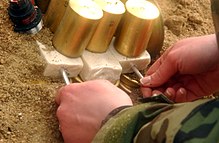Plastic explosives

Plastic explosive is a softer solid form of explosive material. In the field of explosives engineering, plastic explosives are sometimes known as putty explosives.[1]
Plastic explosives are mostly used for explosive destruction. Common plastic explosives include Semtex and C-4.[2] The first made plastic explosive was gelignite in 1875, created by Alfred Nobel.[3]
Types
[change | change source]Composition C
[change | change source]The British used a plastic explosive during World War II for destruction.[4] The material was plastic between 0 and 40 degrees C, but was breakable when colder and more liquid-like when it's very hot. Composition C2 had a bigger temperature range at which it would stay as plastic, from −30 to 52 degrees C. Composition C2 was replaced by Composition C3, which was a mixture of 77% RDX and 23% explosive plasticizer.[5]: 8–109 C3 worked very well but proved to be too breakable in cold weather and was replaced with C4. There are three classes of C4, with differing amounts of RDX and polyisobutylene.[5]: 8–111
-
A 1.25 lb destruction charge of C4 explosive
-
A soldier makes a charge of C4 to cut through solid steel at a destructions range
References
[change | change source]- ↑ Cooper, Paul W. (1996). "Chapter 4: Use forms of explosives". Explosives Engineering. Wiley-VCH. pp. 51–66. ISBN 0-471-18636-8.
- ↑ "Raman Microspectroscopy of Some High Explosives, - Revisited". Chemical Science and Technology Laboratory. Retrieved 27 June 2021.
- ↑ "How to handle gelignite". Wired. 3 February 2011. Retrieved 27 June 2021.
- ↑ Department of the Navy, Bureau of Ordnance (28 May 1947). "U.S. Explosive Ordnance, OP1664". maritime.org. San Francisco National Maritime Park Association. p. 5. Retrieved 12 June 2017.
- ↑ 5.0 5.1 Military Explosives. 1989.


